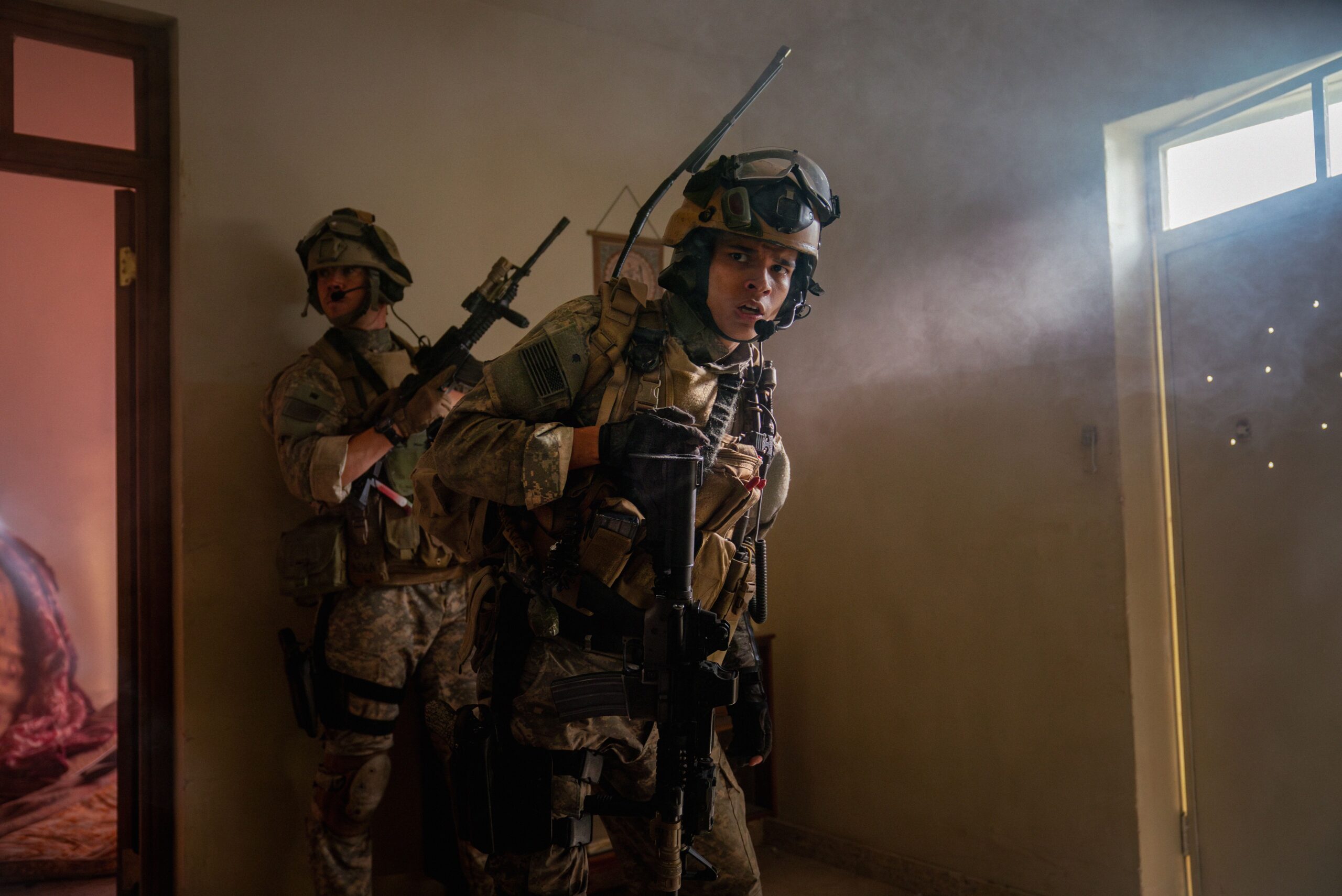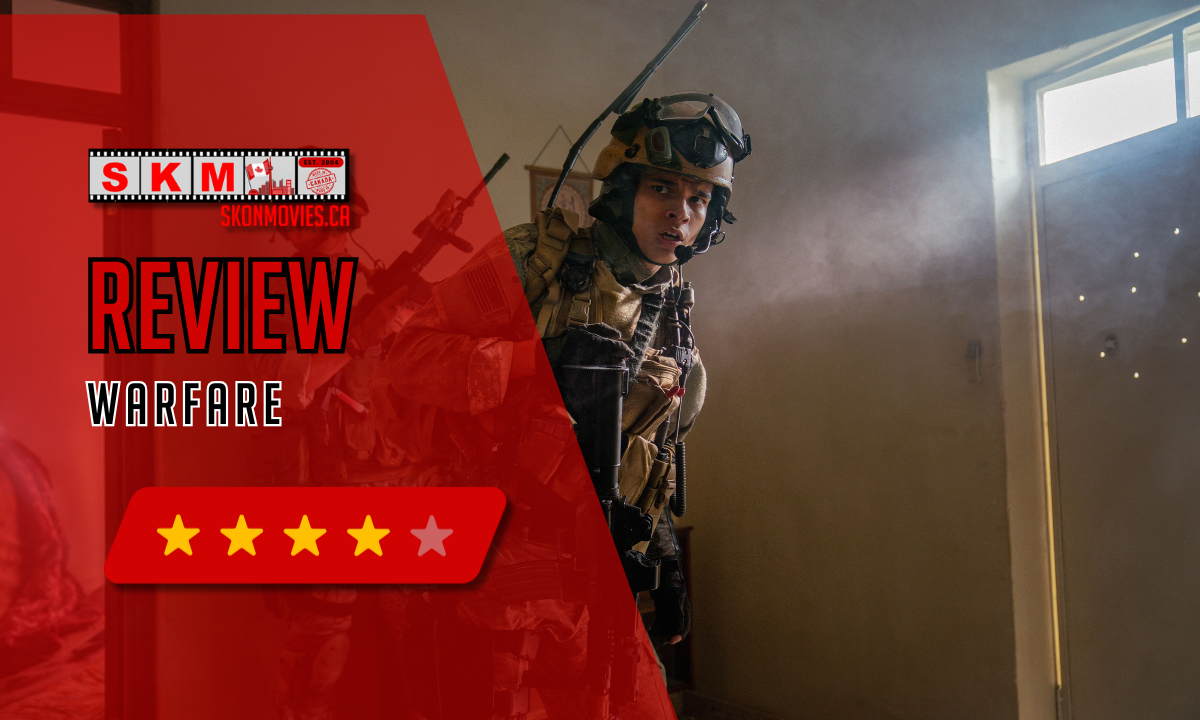Warfare
Content Advisory: Excessive or gratuitous violence
A platoon of Navy SEALS find itself trapped in enemy territory in Warfare. In November 2006, a platoon of Navy SEALs led by C.O. Erik (Will Poulter) and consisting of communicator Ray (D’Pharaoh Woon-A-Tai), Corpsman Elliot (Cosmo Jarvis), Petty Officer Sam (Joseph Quinn), gunner Tommy (Kit Connor), communicator John (Finn Bennett), and sniper Frank (Taylor John Smith), commandeer a house in Ramadi, Iraq for a surveillance mission. However, Iraqi forces begin to attack the platoon, and an I.E.D. explodes during the initial escape attempt, severely injuring some of the SEALS. As they wait for assistance from a second platoon led by Jake (Charles Melton), the SEALS must hold their position against enemy fire.
Warfare Synopsis
Less than a year after releasing Civil War, Alex Gardland (Ex Machina, Annihilation) teams up with Civil War‘s military advisor and real-life Iraq War veteran, Ray Mendoza, to write and direct Warfare. The film is based on Ray Mendoza’s memories from the 2006 Battle of Ramadi, with his on-screen counterpart played by Oji-Cree Canadian actor D’Pharaoh Woon-A-Tai (Hell of a Summer). The film is dedicated to Mendoza’s fellow platoon member Elliot Miller, who is played in the film by Cosmo Jarvis.

Apart from Ray Mendoza and Elliot Miller, the rest of the platoon take on pseudonyms in the film and are played by an ensemble cast that includes Will Poulter (Death of a Unicorn), Joseph Quinn (Stranger Things, Gladiator II), and Charles Melton (May December). The plot of Warfare is depicted in real time, beginning with a nighttime commandeering of the house in Ramadi and slowly building up to an all-out battle. With the platoon’s initial rescue attempt disrupted by an I.E.D., they have to deal with both Iraqi soldiers and injured comrades while they wait for assistance.
My Thoughts on Warfare
When Civil War was released a year ago, I thought that Alex Garland’s speculative narrative about a second United States Civil War hit a little too close to the current political climate, with it still seeming possible that the plot of that film could turn into reality. However, Alex Garland’s work on Civil War put him into contact with US Navy SEAL Ray Mendoza, who worked as a correspondent on the film. By the time that Civil War was released, Garland had already begun collaborating with Mendoza to make a film based on the latter’s experiences fighting in the Iraq War.
There have been a handful of notable films produced in the past two decades set during the Iraq War. Some, like The Hurt Locker, became sleeper hits and Best Picture winners, while others, like American Sniper, became controversial for bending the truth and/or being gung-ho American. Warfare lands somewhere in between those two extremes, though tonally, the film is closer to The Hurt Locker.
While I don’t want to go as far as describing Warfare as an anti-war film, it is indeed a very unglamourous depiction of the horrors of war. This includes arguably the most graphic depiction of wartime violence I have seen since 2001’s Black Hawk Down. While I can usually handle gory visuals in films, Wartime made me sick to the stomach as screaming soldiers are being treated after an I.E.D. explosion that all but destroyed their legs. This is made more effective by the sound mixing, which progresses from the disorienting conclusion in the aftermath of the explosion to absolute chaos back inside the house.
A legitimate criticism of Warfare is that since the action of the film plays out in real time, the first half of the film comes off as slow, since it is mostly just the Navy SEALs doing recon from their comandeered house. However, this also allows for the building of suspense as the snipers begin to spot Iraqi forces gathering across from the house. When the fighting finally starts, it does not let up until the end of the 95-minute film.
Adding to the anti-war message of Warfare is the final scene of the film, depicting the aftermath of the Battle of Ramadi. You forget for much of the film that the house that the US Navy SEALS are occupying was taken by force in the opening scene, with the Iraqi family that lived in the house spending most of the film hiding in one of the rooms. In the closing minutes of Warfare, this family and the other citizens of Ramadi slowly emerge from the rubble, showing the true cost of this war.
One of Ray Mendoza’s goals for making Warfare is to offer a sense of closure for Iraq War veterans. Nobody knows the true horrors of war unless they have been there, and Warfare visualizes why so many veterans came back with PTSD. While the film is not for the faint of heart, Warfare ends up not only being the better of Alex Garland’s two war films but arguably the best Iraq War film since The Hurt Locker.


